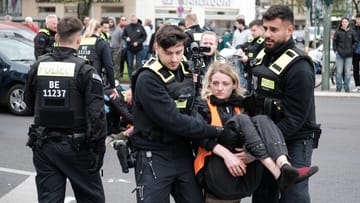Good morning, dear reader,
in a film adaptation of the cases of the lawyer Ferdinand von Schirach it says at the end: “The only thing that separates us from chaos is the law: A thin layer of ice. It’s cold underneath and you die quickly.”
That sounds theatrical. But the sentences are true.
Embed
Whether the Basic Law, the Criminal Code or the Road Traffic Act – these are not technical constructs for a few lawyers. Here are the rules according to which our society lives together. So that the one who can hit harder with his fist doesn’t just get what he wants. So that complete chaos does not break out.
It becomes problematic when those who are supposed to enforce these rules in everyday life no longer stick to them themselves. Then, as it says in the Schirach film, there is a risk of breaking through the ice.
Why am I writing this to you this Wednesday morning? Because Germany obviously has a problem. A study on police violence was presented on Tuesday. A team led by researcher Tobias Singelnstein from Goethe University Frankfurt has been evaluating since 2018 when attacks by police officers occurred.
“Violence in office” is the title of the study. Singelnstein and his team spoke to 3,300 people who say they have been victims of police violence. You have also conducted more than 60 interviews with police officers, prosecutors and judges, and spoken to victim advice centers and lawyers.
The result: Unlawful police violence is almost never reported – and when it is, the cases are dropped in more than 90 percent by the public prosecutor’s office. It is about a high number of unreported cases, not every single case can be reconstructed, and the results are not representative. But the researchers show that the German police must be better controlled. The fact that this study is the first of its kind speaks volumes.
So that there is no misunderstanding here: If police officers are attacked, they must be able to defend themselves. And they also have to enforce the applicable law, whether it’s evictions or demonstrations. Sometimes it takes violence to do that.
But at the moment of their actions, the police officers are seen by many as the incarnate law. As the personified right. It is therefore not irrelevant if a police officer uses a little more pepper spray than necessary. Or when someone else aims the water cannon at the crowd longer and harder than was appropriate. Or just squeeze a little harder so that the fidgeting of those arrested stops. This is where the line between right and wrong lies. And to violence.
There are always different cases going through the media. It’s about the so-called pain grips that police officers use on the “last generation”. Or the case of Sarah N., about which “Zeit Online” reported in detail. She had nothing to do with the demonstrations at the G20 meeting in Hamburg a few years ago, but she was torn off her bike, kicked and dragged to an intersection by police officers. That’s how she tells it today. Or about the 16-year-old refugee who was shot by a police officer in August last year because he was holding a knife. The police officer has since been charged with manslaughter.
Overall, in the overall statistics, public prosecutors bring charges in about 20 percent of investigations. It is different with the officials. According to statistics from the public prosecutor’s office, when police officers are prosecuted for physical harm in office, this only happens in two percent of cases.
In 2021, a total of 80 police officers were charged. According to criminal prosecution statistics from the Federal Statistical Office, 27 of them were convicted. 25 were acquitted and 28 accused were dismissed by the court. The conviction rate was 34 percent. This is also significantly lower than the average for all criminal proceedings. There it is 81 percent.
The team led by researcher Singelnstein admits: “The boundaries between appropriate and excessive police force are fluid and not always easy to draw.” In most cases (81 percent) other police officers were present when a colleague, mostly men, struck.
The reasons for this are different, according to the investigations: officials rarely testify against each other, there is apparently an esprit de corps. The public prosecutor’s office, on the other hand, often believes the police, after all, they work closely together on a day-to-day basis.
A fifth of those affected by police violence in the study state that failure to follow instructions led to the escalation. In addition, the police measures were not understandable for many before the violence broke out. The officers, in turn, said that staff shortages and time pressures led them and colleagues to use excessive force.
So the German police sometimes hurt a citizen because things have to be done quickly? You really don’t want to believe that. And yes, there may be isolated cases, because most of the officials do their job properly. However, the study shows that the police must work more transparently.
In several federal states there is already a commissioner for police violence. This item must become standard in all countries. And yes, more body cams, i.e. small cameras that are attached to the upper bodies of the officers and record their actions, are an option. Special standards apply to those who enforce the law.
Singelnstein also advocates an independent investigative agency to reduce difficulties in criminal prosecution. According to the “Süddeutsche Zeitung”, the researcher himself says: “Despite all my dealings with the subject: I was surprised at how little the power of those affected to complain is and how great the police’s power of definition is.”
If this analysis is correct, then the following applies: It must not stay that way. Otherwise, trust in the rule of law will dwindle. And the ice breaks.
The trial against five suspected members of a terrorist group that is said to have planned a coup in Germany begins today in Koblenz. There are four men, between 44 and 56 years old, and a 75-year-old woman. The accusation: planning to found a terrorist organization. The five accused are also said to have planned to kidnap Federal Minister of Health Karl Lauterbach.


